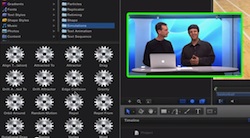This week on MacBreak Studio, I talk with Steve Martin from Ripple Training about using behaviors instead of keyframes for creating animation in Motion.
Almost everything in Motion can be animated either with traditional keyframing methods or by using procedural objects called behaviors: this includes not only animating objects to change position, scale, and rotation in various ways, but also animating things like replicators, particle emitters, shapes, text, and even cameras.
In this example, we pick back up where we left off in the last two episodes in which we animated a ball to bounce, spin, and grow with keyframes and we look at how you could achieve the same result with behaviors in order to understand the benefits and limitations of each approach. While behaviors are often faster and easier to use for ongoing or repeating animation, if you want an object to start and stop moving, rotating, scaling or otherwise animating on specific frames with realistic “easing” or acceleration and deceleration, in those instances I generally rely on keyframes.


